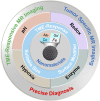Recent Advances in Nanotheranostic Agents for Tumor Microenvironment-Responsive Magnetic Resonance Imaging
- PMID: 35814250
- PMCID: PMC9257028
- DOI: 10.3389/fphar.2022.924131
Recent Advances in Nanotheranostic Agents for Tumor Microenvironment-Responsive Magnetic Resonance Imaging
Abstract
Nanomaterials integrating a variety of excellent properties (such as controllable/suitable size, surface modifier, and multifunctionality) have attracted increasing attention in the biomedical field and have been considered a new generation of magnetic resonance imaging (MRI) contrast agents (CAs). In recent years, stimuli-responsive nanomaterials with specifically responsive ability have been synthesized as MRI CAs, which can significantly improve the diagnostic sensitivity and accuracy depending on their outstanding performance. Furthermore, the inherent tumor microenvironment (TME) of malignant tumor is considered to possess several unique features, such as low extracellular pH, redox condition, hypoxia, and high interstitial pressure, that are significantly different from healthy tissues. Hence, constructing nanomaterials for TME-responsive MRI as an emerging strategy is expected to overcome the current obstacles to precise diagnosis. This review focuses on recent advances of nanomaterials in their application of TME-responsive MRI that trigger the diagnostic function in response to various endogenous stimulations, including pH, redox, enzyme, and hypoxia. Moreover, the future challenges and trends in the development of nanomaterials serving as TME-responsive MRI CAs are discussed.
Keywords: MRI; diagnosis of cancer; nanomaterials; stimuli-responsive; tumor microenvironment.
Copyright © 2022 Jin, Yang, Wang, Li and Xu.
Conflict of interest statement
The authors declare that the research was conducted in the absence of any commercial or financial relationships that could be construed as a potential conflict of interest.
Figures
Similar articles
-
Tumor Therapy Strategies Based on Microenvironment-Specific Responsive Nanomaterials.Adv Healthc Mater. 2023 Aug;12(20):e2300153. doi: 10.1002/adhm.202300153. Epub 2023 Apr 9. Adv Healthc Mater. 2023. PMID: 36933000 Review.
-
Recent Advance in Tumor Microenvironment-Based Stimuli-Responsive Nanoscale Drug Delivery and Imaging Platform.Front Pharmacol. 2022 Jul 22;13:929854. doi: 10.3389/fphar.2022.929854. eCollection 2022. Front Pharmacol. 2022. PMID: 35935835 Free PMC article. Review.
-
Biomedical applications of stimuli-responsive nanomaterials.MedComm (2020). 2024 Jul 20;5(8):e643. doi: 10.1002/mco2.643. eCollection 2024 Aug. MedComm (2020). 2024. PMID: 39036340 Free PMC article. Review.
-
Designing Hypoxia-Responsive Nanotheranostic Agents for Tumor Imaging and Therapy.Adv Healthc Mater. 2021 Mar;10(5):e2001277. doi: 10.1002/adhm.202001277. Epub 2020 Sep 28. Adv Healthc Mater. 2021. PMID: 32985141 Review.
-
Bioparameter-directed nanoformulations as MRI CAs enable the specific visualization of hypoxic tumour.Analyst. 2023 Oct 5;148(20):4967-4981. doi: 10.1039/d3an00972f. Analyst. 2023. PMID: 37724375 Review.
Cited by
-
Iron Oxide Nanoparticle-Based T1 Contrast Agents for Magnetic Resonance Imaging: A Review.Nanomaterials (Basel). 2024 Dec 28;15(1):33. doi: 10.3390/nano15010033. Nanomaterials (Basel). 2024. PMID: 39791792 Free PMC article. Review.
-
Nanoparticle-Based Activatable MRI Probes for Disease Imaging and Monitoring.Chem Biomed Imaging. 2023 Mar 29;1(3):192-204. doi: 10.1021/cbmi.3c00024. eCollection 2023 Jun 26. Chem Biomed Imaging. 2023. PMID: 39473694 Free PMC article. Review.
References
-
- Cao Y., Mao Z., He Y., Kuang Y., Liu M., Zhou Y., et al. (2020). Extremely Small Iron Oxide Nanoparticle-Encapsulated Nanogels as a Glutathione-Responsive T1 Contrast Agent for Tumor-Targeted Magnetic Resonance Imaging. ACS Appl. Mater Interfaces 12 (24), 26973–26981. 10.1021/acsami.0c07288 - DOI - PubMed
-
- Chen Y., Yin Q., Ji X., Zhang S., Chen H., Zheng Y., et al. (2012). Manganese Oxide-Based Multifunctionalized Mesoporous Silica Nanoparticles for pH-Responsive MRI, Ultrasonography and Circumvention of MDR in Cancer Cells. Biomaterials 33 (29), 7126–7137. 10.1016/j.biomaterials.2012.06.059 - DOI - PubMed
Publication types
LinkOut - more resources
Full Text Sources


